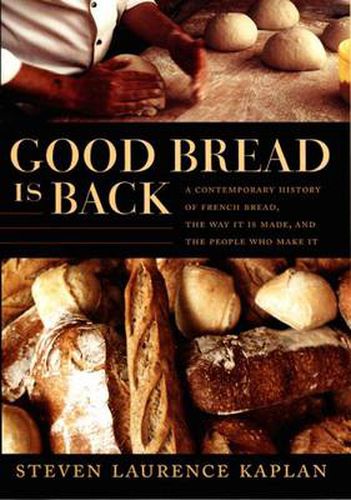Readings Newsletter
Become a Readings Member to make your shopping experience even easier.
Sign in or sign up for free!
You’re not far away from qualifying for FREE standard shipping within Australia
You’ve qualified for FREE standard shipping within Australia
The cart is loading…






Good Bread Is Back is a beautifully illustrated book for foodies and Francophiles alike. Widely recognized as a leading expert on French bread, the historian Steven Laurence Kaplan takes readers into aromatic Parisian bakeries as he explains how good bread began to reappear in France in the 1990s, following almost a century of decline in quality. Kaplan sets the stage for the comeback of good bread by describing how, while bread comprised the bulk of the French diet during the eighteenth century, by the twentieth, per capita consumption had dropped off precipitously. This was largely due to social and economic modernization and the availability of a wider choice of foods. But part of the problem was that the bread did not taste good. Centuries-old artisanal bread making techniques were giving way to conveyor belts that churned out flavourless fluff. In a culture where bread is sacrosanct, as it is in France, bad bread was more than a gastronomical disappointment. It was a threat to France’s sense of itself.With a nudge from the millers (who make the flour) and assistance from the government, bakers rallied, reclaiming their reputations as artisans by marketing their traditionally made loaves as the authentic French bread. By the mid-1990s, bread officially designated as bread of the French tradition –bread made without additives or freezing–was in demand throughout Paris. What makes this artisanal bread good? Kaplan explains, meticulously describing the ideal crust and crumb (interior), mouth feel, aroma, and taste. He discusses the bread making process in extraordinary detail, from the ingredients to the kneading, shaping, and baking to the sound bread should make when it comes out of the oven. He offers a system for assessing bread’s quality and a language for discussing its attributes. A historian and a connoisseur, Kaplan does more than tell the story of the revival of good bread in France. He makes the reader see, smell, taste, feel, and even hear why it is so very wonderful that good bread is back.
$9.00 standard shipping within Australia
FREE standard shipping within Australia for orders over $100.00
Express & International shipping calculated at checkout
Good Bread Is Back is a beautifully illustrated book for foodies and Francophiles alike. Widely recognized as a leading expert on French bread, the historian Steven Laurence Kaplan takes readers into aromatic Parisian bakeries as he explains how good bread began to reappear in France in the 1990s, following almost a century of decline in quality. Kaplan sets the stage for the comeback of good bread by describing how, while bread comprised the bulk of the French diet during the eighteenth century, by the twentieth, per capita consumption had dropped off precipitously. This was largely due to social and economic modernization and the availability of a wider choice of foods. But part of the problem was that the bread did not taste good. Centuries-old artisanal bread making techniques were giving way to conveyor belts that churned out flavourless fluff. In a culture where bread is sacrosanct, as it is in France, bad bread was more than a gastronomical disappointment. It was a threat to France’s sense of itself.With a nudge from the millers (who make the flour) and assistance from the government, bakers rallied, reclaiming their reputations as artisans by marketing their traditionally made loaves as the authentic French bread. By the mid-1990s, bread officially designated as bread of the French tradition –bread made without additives or freezing–was in demand throughout Paris. What makes this artisanal bread good? Kaplan explains, meticulously describing the ideal crust and crumb (interior), mouth feel, aroma, and taste. He discusses the bread making process in extraordinary detail, from the ingredients to the kneading, shaping, and baking to the sound bread should make when it comes out of the oven. He offers a system for assessing bread’s quality and a language for discussing its attributes. A historian and a connoisseur, Kaplan does more than tell the story of the revival of good bread in France. He makes the reader see, smell, taste, feel, and even hear why it is so very wonderful that good bread is back.